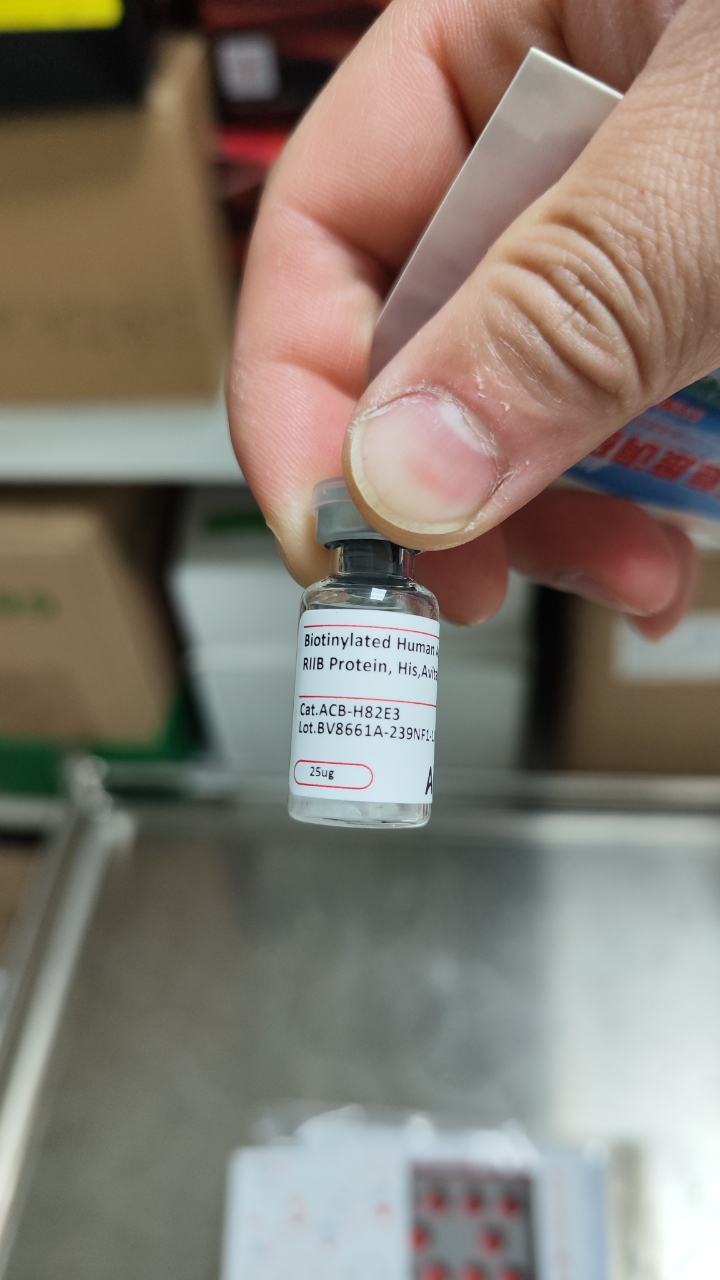分子别名(Synonym)
ACVR2B,ACTRIIB,MGC116908
表达区间及表达系统(Source)
Biotinylated Human Activin RIIB Protein, His,Avitag (ACB-H82E3) is expressed from human 293 cells (HEK293). It contains AA Ser 19 - Thr 137 (Accession # Q13705-1 ).
Predicted N-terminus: Ser 19
Request for sequence
蛋白结构(Molecular Characterization)

This protein carries a polyhistidine tag at the C-terminus, followed by an Avi tag (Avitag™).
The protein has a calculated MW of 17.2 kDa. The protein migrates as 25-40 kDa when calibrated against Star Ribbon Pre-stained Protein Marker under reducing (R) condition (SDS-PAGE) due to glycosylation.
标记(Labeling)
Biotinylation of this product is performed using Avitag™ technology. Briefly, the single lysine residue in the Avitag is enzymatically labeled with biotin.
蛋白标记度(Protein Ratio)
Passed as determined by the HABA assay / binding ELISA.
内毒素(Endotoxin)
Less than 1.0 EU per μg by the LAL method.
纯度(Purity)
>90% as determined by SDS-PAGE.
制剂(Formulation)
Lyophilized from 0.22 μm filtered solution in PBS, pH7.4 with trehalose as protectant.
Contact us for customized product form or formulation.
重构方法(Reconstitution)
Please see Certificate of Analysis for specific instructions.
For best performance, we strongly recommend you to follow the reconstitution protocol provided in the CoA.
存储(Storage)
For long term storage, the product should be stored at lyophilized state at -20°C or lower.
Please avoid repeated freeze-thaw cycles.
This product is stable after storage at:
- -20°C to -70°C for 12 months in lyophilized state;
- -70°C for 3 months under sterile conditions after reconstitution.
质量管理控制体系(QMS)
电泳(SDS-PAGE)

Biotinylated Human Activin RIIB Protein, His,Avitag on SDS-PAGE under reducing (R) condition. The gel was stained with Coomassie Blue. The purity of the protein is greater than 90% (With Star Ribbon Pre-stained Protein Marker).
活性(Bioactivity)-ELISA

Immobilized Human Latent Activin A, His Tag (Cat. No. ACA-H424x) at 5 μg/mL (100 μL/well) can bind Biotinylated Human Activin RIIB Protein, His,Avitag (Cat. No. ACB-H82E3) with a linear range of 0.005-0.313 μg/mL (QC tested).
Protocol

Immobilized Human Activin A Protein, Tag Free (Cat. No. ACA-H421b) at 5 μg/mL (100 μL/well) can bind Biotinylated Human Activin RIIB Protein, His,Avitag (Cat. No. ACB-H82E3) with a linear range of 0.3-5 ng/mL (Routinely tested).
Protocol
活性(Bioactivity)-SPR

Biotinylated Human Activin RIIB Protein, His,Avitag (Cat. No. ACB-H82E3) immobilized on CM5 Chip can bind Human Latent Activin A, His Tag (Cat. No. ACA-H424x) with an affinity constant of 0.147 nM as determined in a SPR assay (Biacore 8K) (Routinely tested).
Protocol
 +添加评论
+添加评论背景(Background)
Activin receptor type-2B (ACVR2B) is also known as ActR-IIB and MGC116908, ACVR2B is an activin type 2 receptor. Activins are dimeric growth and differentiation factors which belong to the transforming growth factor-beta (TGF-beta) superfamily of structurally related signaling proteins. Activins signal through a heteromeric complex of receptor serine kinases which include at least two type I (I and IB) and two type II (II and IIB) receptors. These receptors are all transmembrane proteins, composed of a ligand-binding extracellular domain with cysteine-rich region, a transmembrane domain, and a cytoplasmic domain with predicted serine/threonine specificity. Type I receptors are essential for signaling; and type II receptors are required for binding ligands and for expression of type I receptors. Type I and II receptors form a stable complex after ligand binding, resulting in phosphorylation of type I receptors by type II receptors. Type II receptors are considered to be constitutively active kinases. This gene encodes activin A type IIB receptor, which displays a 3- to 4-fold higher affinity for the ligand than activin A type II receptor. Defects in ACVR2B are the cause of visceral heterotaxy autosomal type 4 (HTX4).























































 膜杰作
膜杰作 Star Staining
Star Staining

















